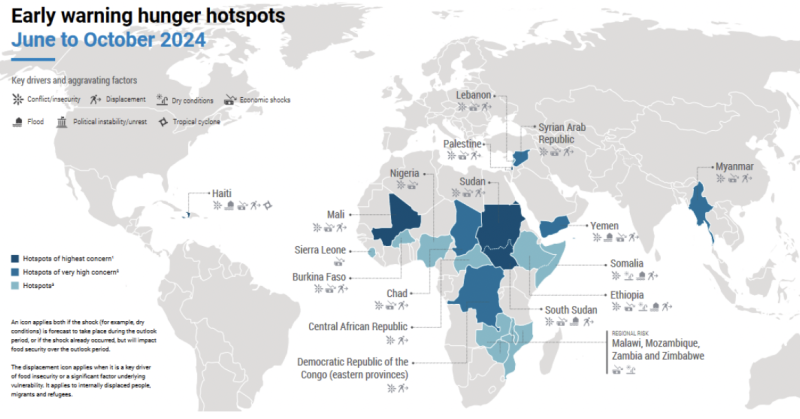Highlights:
The Food and Agriculture Organization of the United Nations (FAO) and the World Food Programme (WFP) warn that acute food insecurity is likely to deteriorate further in 18 hunger hotspots, including a total of 17 countries or territories and one regional cluster which comprises 4 countries, during the outlook period from June to October 2024.
Mali, Palestine, South Sudan and the Sudan remain at the highest concern level. Haiti was added to the list of countries/territories of highest concern due to escalating violence by non-state armed groups (NSAGs). This category includes hotspots with Famine or Risk of Famine, or with populations already in Catastrophe (Integrated Food Security Phase Classification [IPC]/Cadre Harmonisé [CH] Phase 5) or at risk of deterioration towards catastrophic conditions during the outlook period. These countries/territories require the most urgent attention.
Chad, the Democratic Republic of the Congo (eastern provinces), Myanmar, the Syrian Arab Republic and Yemen are hotspots of very high concern. All these hotspots have a high number of people facing or projected to face critical levels of acute food insecurity, coupled with worsening drivers that are expected to further exacerbate life-threatening conditions in the coming months.
Since the October 2023 edition, the Central African Republic, Lebanon, Mozambique, Myanmar, Nigeria, Sierra Leone and Zambia have been added to the list of hunger hotspots, while Burkina Faso, Ethiopia, Malawi, Somalia and Zimbabwe remain hunger hotspot countries.
Armed violence and conflict remain the primary causes of acute food insecurity across numerous hunger hotspots. In these situations, widespread displacement, destruction of food systems and reduced humanitarian access are likely to worsen food availability and access.
Conflict and instability are compounded by a contraction of economic growth in emerging markets and developing economies. Many countries worldwide continue struggling with high debt levels – preventing many governments from protecting their most vulnerable populations – while there are no clear signs of relief from the high costs of debt.
Geopolitical tensions in the Near East and North Africa region and potential new escalations remain a major risk for the global economy in 2024. Increased energy and transportation costs, currency depreciation and challenges in financing food imports could exert upward pressure on domestic prices in numerous vulnerable countries in 2024.
Weather extremes, such as excessive rains, tropical storms, cyclones, flooding, drought and increased climate variability, remain significant drivers of acute food insecurity in some countries and regions. La Niña is expected to prevail between August 2024 and February 2025, significantly influencing rainfall distribution and temperatures.
Ongoing or planned reductions and gaps in emergency agriculture, food and livelihood assistance will continue to affect several hunger hotspots. Urgent and scaled-up assistance is therefore required in all 18 hunger hotspots to protect livelihoods and increase access to food.
This report provides country-specific recommendations on priorities for emergency response, as well as anticipatory actions to address existing humanitarian needs and ensure short-term protective interventions before new needs materialize.

| Year of publication | |
| Geographic coverage | Democratic Republic of the CongoPalestineSierra LeoneMozambiqueMyanmarNigeriaYemenZambiaZimbabweSudanSouth SudanSomaliaSyrian Arab republicCentral African RepublicChadBurkina FasoLebanonMalawiMaliEthiopiaHaitiGlobal |
| Originally published | 06 Jun 2024 |
| Related organisation(s) | FAO - Food and Agriculture Organization of the United NationsWFP - World Food Programme |
| Knowledge service | Metadata | Global Food and Nutrition Security | Food security and food crisesClimate extremes and food security | FamineAccess to food |
| Digital Europa Thesaurus (DET) | humanitarian aideconomic conditionsConflictHotspotextreme weather |
